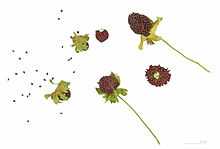Mock strawberry
| Mock strawberry | |
|---|---|
 | |
| Scientific classification | |
| Kingdom: | Plantae |
| (unranked): | Angiosperms |
| (unranked): | Eudicots |
| (unranked): | Rosids |
| Order: | Rosales |
| Family: | Rosaceae |
| Genus: | Potentilla |
| Species: | P. indica |
| Binomial name | |
| Potentilla indica (Andrews) Th.Wolf | |

Potentilla indica (formerly Duchesnea indica), also called mock strawberry, Gurbir, Indian strawberry or false strawberry, has foliage and an aggregate accessory fruit similar to true strawberry, though it is classified in a different genus, and has yellow flowers, unlike the white or slightly pink flowers of true strawberries. It is native to eastern and southern Asia, but has been introduced to many other areas as an ornamental plant. It has been naturalized in many regions, including the southern United States, and is considered a invasive species in some regions.[1][2] It is considered one of the most invasive plants on the island of Réunion.[3]
The leaves are trifoliate, roughly veined beneath, dark green, and often persisting through the winter, arising from short crowns. The plant spreads along creeping stolons, rooting and producing crowns at each node. The yellow flowers are produced in mid spring, then sporadically throughout the growing season. The aggregate accessory fruits are white or red, and entirely covered with red achenes, simple ovaries, each containing a single seed. They are edible, but they have very little flavor.
Recent genetic evidence has shown that this genus is better included within Potentilla,[4] but currently most sources still list it in the genus Duchesnea.
A poultice of the crushed leaves is used to treat skin ailments such as eczema.[5]

References
- ↑ "Invasive species in Belgium: Duchesnea indica". Retrieved 22 November 2013.
- ↑ Missouri department of Conservation. "Indian Strawberry (Mock Strawberry)". Retrieved 22 November 2013. "This plant is invasive in many locations across America."
- ↑ Global invasive species database. "Ecology of Duchesnea indica". Retrieved 22 November 2013.
- ↑ Torsten Eriksson, Malin S. Hibbs, Anne D. Yoder, Charles F. Delwiche, and Michael J. Donoghue (2003). "The Phylogeny of Rosoideae (Rosaceae) Based on Sequences of the Internal Transcribed Spacers (ITS) of Nuclear Ribosomal DNA and the trnL/F Region of Chloroplast DNA". Int. J Plant Sci. 164 (2): 197–211. doi:10.1086/346163.
- ↑ O’Brien, Meghan (2006). "Indian Strawberry". Bellarmine University. Retrieved 2013-09-28.
External links
| Wikimedia Commons has media related to Duchesnea indica. |
| Wikibooks' A Wikimanual of Gardening has more about this subject: |